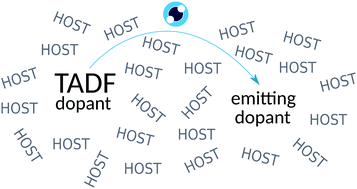Exciton energy transfer in organic light emitting diodes with thermally activated delayed fluorescence dopants†
Abstract
Molecular systems exhibiting thermally activated delayed fluorescence (TADF) are widely used as fluorescent dopants in organic light-emitting diodes (OLEDs) due to their capacity to harvest triplet excitons. The optoelectronic properties of a TADF-based OLED can be further improved by co-depositing a highly luminescent fluorophore into the emissive layer. In a double-dopant architecture, electrically generated excitons on the TADF molecules are transmitted to the fluorescent emitter for radiative recombination. In this theoretical study, we investigate the ability of singlet excitons on PXZ-TRZ to non-radiatively hop to Rubrene by varying the ambient temperature and solvent polarity. The non-zero probability of the exciton energy transfer is attributed to the vibronic interaction between the charge-transfer (CT) and optically bright high-lying states of the TADF monomer. We systematically extend the outcome of our calculations to a similar class of dimers and discuss how the preferential orientation of linear shaped TADF molecules and their complementary fluorophores can enhance the efficiency of energy transfer.



 Please wait while we load your content...
Please wait while we load your content...